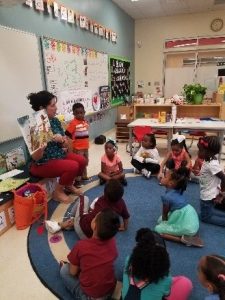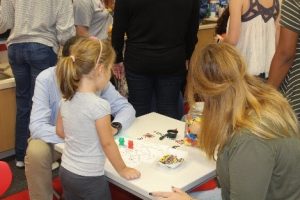By: Julia López-Robertson, University of South Carolina and Rocio Herron, Jackson Creek Elementary School
Last fall I taught a Family Dynamics course and was searching for a way to engage my undergraduate students in meaningful experiences with children and families; the course carries a community service component that is left up to the instructor to design and implement. I sought to involve my students in experiences that would help them develop strategies for authentic family and community engagement that they could later draw upon when they became classroom teachers.

I am very fortunate to be able to spend time in a local Pre-K classroom with a teacher, Rocio Herron, who willingly shares her students and families with me. Rocio has taught at Jackson Creek Elementary School since the school opened three years ago; the majority of the school population is African American (73%), followed by Latino students (13%), and 100% of the students receive free/reduced lunch.
Rocio and I have a history; she was my youngest son’s Pre-K teacher a few years ago (he is now 15). Rocio and I share similar views on teaching and learning and family engagement; we believe that children have a right to their language; children must be actively engaged in their learning; teachers must learn about their children lives outside of school in order to better teach them; and that trusting relationships with families are the cornerstone of teaching.
Family Heritage Project

I spend Friday mornings in Rocio’s classroom engaging the children in bilingual (Spanish/English) read alouds, songs, dances, and games. One Friday I mentioned to Rocio that I was teaching a course with a community service component and wondered if she had any ideas for my class. I explained the time commitment and my goals for the project and she excitedly exclaimed that she had a Family Heritage Project she was looking to do that would involve all three Pre-K classrooms.

The purpose for the Pre-K Family Heritage project was to get to know the children and their families by engaging them in a project about their family. Rocio explained that she also wanted the families to know that they all had things to be proud of and to contribute to the school and society in general; too often our immigrant families and families of color are made to feel insignificant and that they have nothing to offer our schools or their children. Through the project, the families would investigate their heritage, family, and culture and uncover for themselves the tools they possess that can be used for helping their children learn; i.e. language, sewing, gardening. I wanted my students to view the families as contributors of knowledge and see them through an asset-based lens where their funds of knowledge, their community-based ways of knowing (Moll, Amanti, Neff, González, 1992) are recognized as valuable instruments for school learning.

The Family Heritage Project spanned a few weeks in the fall semester. Families were asked to come to school on three evenings; my students and I participated in all activities that took place over the three visits. The first evening was spent getting to know each other; Rocio engaged the families in a read aloud followed by a discussion, families sang songs that the children did in school, families played school games with the children and we all got to know each other. We expanded the view of ‘family heritage’ to include things that you do together as a family because we wanted to be inclusive of all families. Rocio asked them to think about things that they did together and gave the example of her spending time at the beach while in her home country of Costa Rica; she showed her beach bag and other artifacts. I shared that my family enjoyed going on road trips and explained that my artifact would be a car and a roadmap.

The second evening the families worked on creating a physical representation, an artifact, of their family and/or family heritage using supplies we had at school; paper, cereal boxes, soup cans, etc. The only rule for the artifacts was that they had to be handmade, nothing could be store bought. There was so much excitement, so many conversations and a busy hum filled the room! The third and final evening was a potluck celebration where each family shared their artifact and story with the group, the children presented a song, and we celebrated with a meal. I shared my car and road map representing our love of road trips, my students also shared their various artifacts as did all of the teachers. Artifacts were displayed on tables for all to see. Once everyone shared, we had our meal which was the annual Thanksgiving celebration.


As I walked around, I heard laughter, families making connections with one another and sharing stories! It was truly joyful!
What would we do different?
We were so eager for the project that we held the events in one month! We realize that having the meetings so close inhibited attendance, especially for the second meeting. The next time we do this, we will space out the meetings over a couple of months or over six weeks.
Closing thoughts
As noted above immigrant families and families of color are often viewed through a deficit lens where what they do not posses is highlighted, for example; families do not know English or they live in a high poverty area. One of our main goals for the Family Heritage Night was for families to uncover their own riches and recognize that they indeed posses knowledge, skills, and strategies that will help their children succeed in school. Engaging the undergraduate students helped them see this firsthand and also helped them see that family engagement is not scary. Finally, if we approach our families with love and respect and demonstrate that in everything that we do and say, our families begin to trust us and a trusting relationship with families is the foundation upon which everything is built.
References
Moll, L. C., Amanti, C., Neff, D., & González, N. (1992). Funds of knowledge for teaching: Using a qualitative approach to connect homes and classrooms. Theory into practice, 31(2), 132-141.
About the Authors

Julia López-Robertson is a Professor of Instruction & Teacher Education at the University of South Carolina.

Rocio Herron is a Pre-K teacher Jackson Creek Elementary School.
